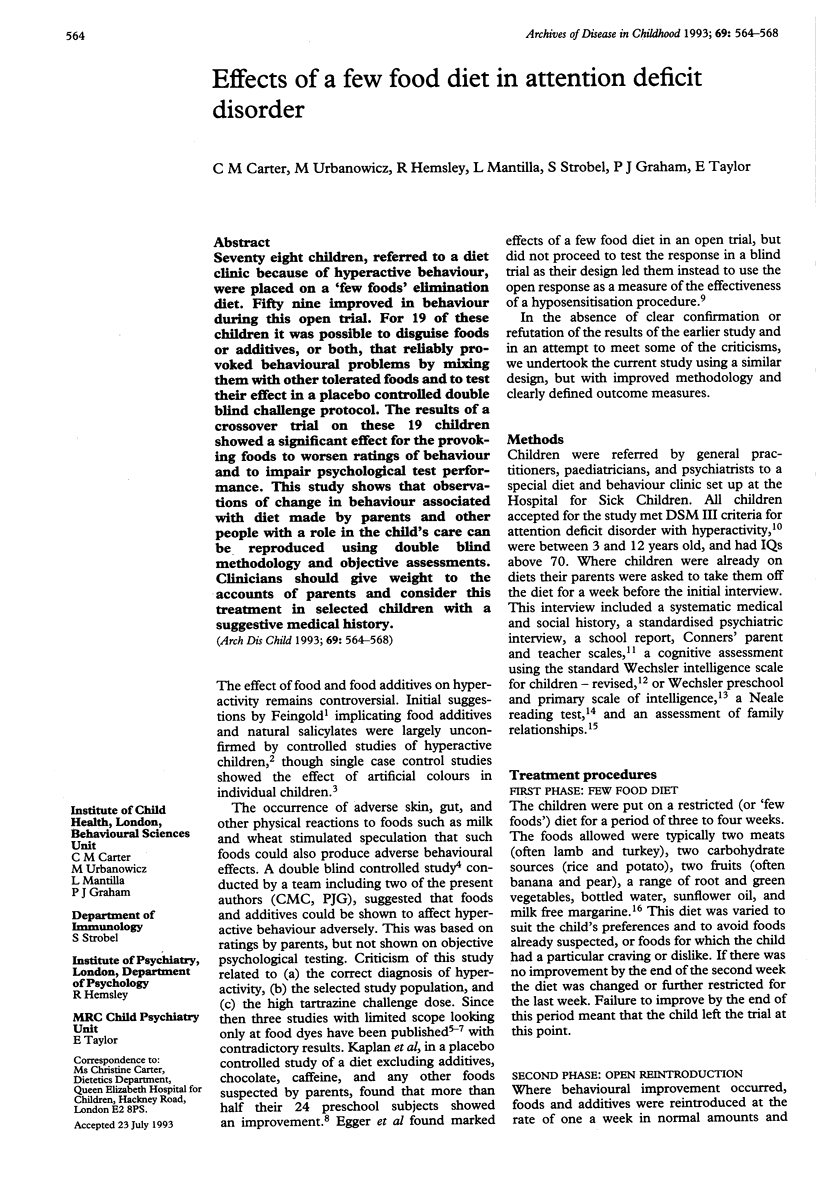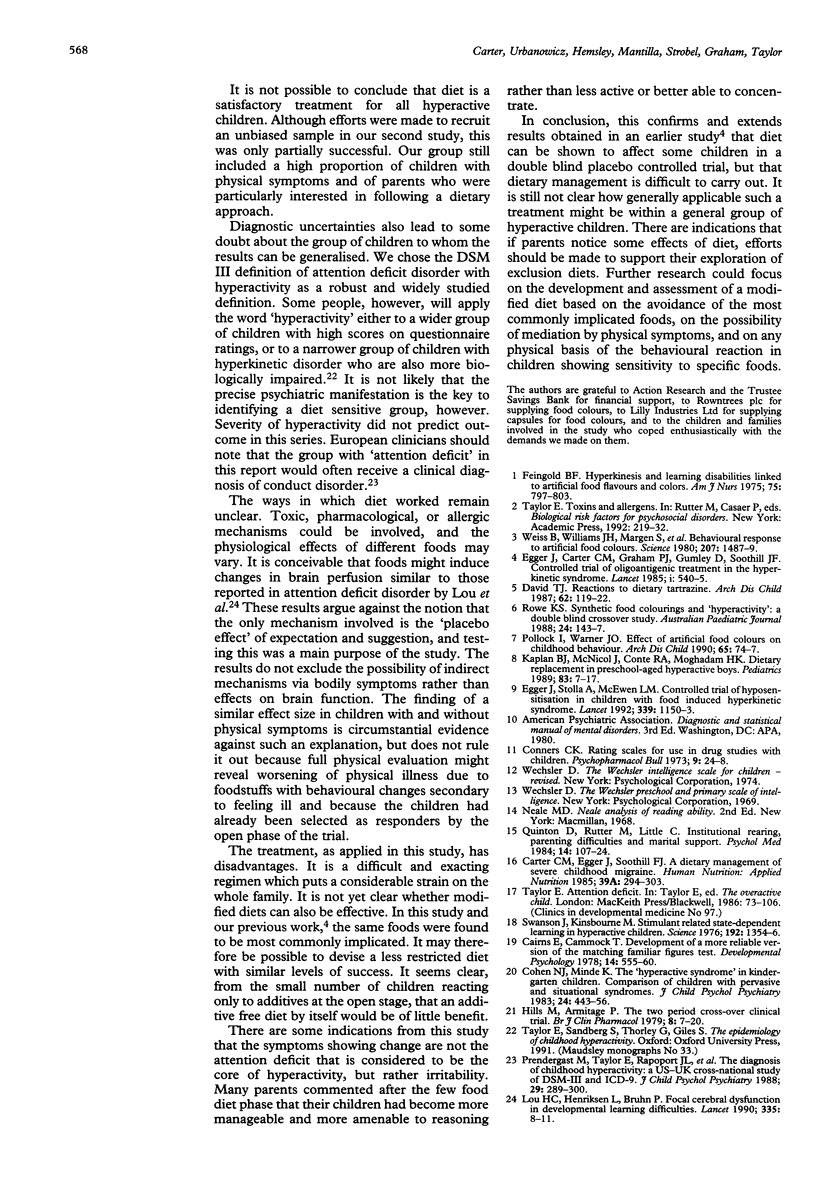Abstract
Seventy-eight children, referred to a diet clinic because of hyperactive behaviour, were placed on a 'few foods' elimination diet. Fifty nine improved in behaviour during this open trial. For 19 of these children it was possible to disguise foods or additives, or both, that reliably provoked behavioural problems by mixing them with other tolerated foods and to test their effect in a placebo controlled double blind challenge protocol. The results of a crossover trial on these 19 children showed a significant effect for the provoking foods to worsen ratings of behaviour and to impair psychological test performance. This study shows that observations of change in behaviour associated with diet made by parents and other people with a role in the child's care can be reproduced using double blind methodology and objective assessments. Clinicians should give weight to the accounts of parents and consider this treatment in selected children with a suggestive medical history.
Full text
PDF




Selected References
These references are in PubMed. This may not be the complete list of references from this article.
- Carter C. M., Egger J., Soothill J. F. A dietary management of severe childhood migraine. Hum Nutr Appl Nutr. 1985 Aug;39(4):294–303. [PubMed] [Google Scholar]
- Cohen N. J., Minde K. The 'hyperactive syndrome' in kindergarten children: comparison of children with pervasive and situational symptoms. J Child Psychol Psychiatry. 1983 Jul;24(3):443–455. doi: 10.1111/j.1469-7610.1983.tb00120.x. [DOI] [PubMed] [Google Scholar]
- David T. J. Reactions to dietary tartrazine. Arch Dis Child. 1987 Feb;62(2):119–122. doi: 10.1136/adc.62.2.119. [DOI] [PMC free article] [PubMed] [Google Scholar]
- Egger J., Carter C. M., Graham P. J., Gumley D., Soothill J. F. Controlled trial of oligoantigenic treatment in the hyperkinetic syndrome. Lancet. 1985 Mar 9;1(8428):540–545. doi: 10.1016/s0140-6736(85)91206-1. [DOI] [PubMed] [Google Scholar]
- Egger J., Stolla A., McEwen L. M. Controlled trial of hyposensitisation in children with food-induced hyperkinetic syndrome. Lancet. 1992 May 9;339(8802):1150–1153. doi: 10.1016/0140-6736(92)90742-l. [DOI] [PubMed] [Google Scholar]
- Feingold B. F. Hyperkinesis and learning disabilities linked to artificial food flavors and colors. Am J Nurs. 1975 May;75(5):797–803. [PubMed] [Google Scholar]
- Hills M., Armitage P. The two-period cross-over clinical trial. Br J Clin Pharmacol. 1979 Jul;8(1):7–20. doi: 10.1111/j.1365-2125.1979.tb05903.x. [DOI] [PMC free article] [PubMed] [Google Scholar]
- Kaplan B. J., McNicol J., Conte R. A., Moghadam H. K. Dietary replacement in preschool-aged hyperactive boys. Pediatrics. 1989 Jan;83(1):7–17. [PubMed] [Google Scholar]
- Lou H. C., Henriksen L., Bruhn P. Focal cerebral dysfunction in developmental learning disabilities. Lancet. 1990 Jan 6;335(8680):8–11. doi: 10.1016/0140-6736(90)90136-s. [DOI] [PubMed] [Google Scholar]
- Pollock I., Warner J. O. Effect of artificial food colours on childhood behaviour. Arch Dis Child. 1990 Jan;65(1):74–77. doi: 10.1136/adc.65.1.74. [DOI] [PMC free article] [PubMed] [Google Scholar]
- Prendergast M., Taylor E., Rapoport J. L., Bartko J., Donnelly M., Zametkin A., Ahearn M. B., Dunn G., Wieselberg H. M. The diagnosis of childhood hyperactivity. A U.S.-U.K. cross-national study of DSM-III and ICD-9. J Child Psychol Psychiatry. 1988 May;29(3):289–300. doi: 10.1111/j.1469-7610.1988.tb00717.x. [DOI] [PubMed] [Google Scholar]
- Quinton D., Rutter M., Liddle C. Institutional rearing, parenting difficulties and marital support. Psychol Med. 1984 Feb;14(1):107–124. doi: 10.1017/s0033291700003111. [DOI] [PubMed] [Google Scholar]
- Rowe K. S. Synthetic food colourings and 'hyperactivity': a double-blind crossover study. Aust Paediatr J. 1988 Apr;24(2):143–147. doi: 10.1111/j.1440-1754.1988.tb00307.x. [DOI] [PubMed] [Google Scholar]
- Swanson J. M., Kinsbourne M. Stimulant-related state-dependent learning in hyperactive children. Science. 1976 Jun 25;192(4246):1354–1357. doi: 10.1126/science.1273596. [DOI] [PubMed] [Google Scholar]
- Weiss B., Williams J. H., Margen S., Abrams B., Caan B., Citron L. J., Cox C., McKibben J., Ogar D., Schultz S. Behavioral responses to artificial food colors. Science. 1980 Mar 28;207(4438):1487–1489. doi: 10.1126/science.7361103. [DOI] [PubMed] [Google Scholar]


